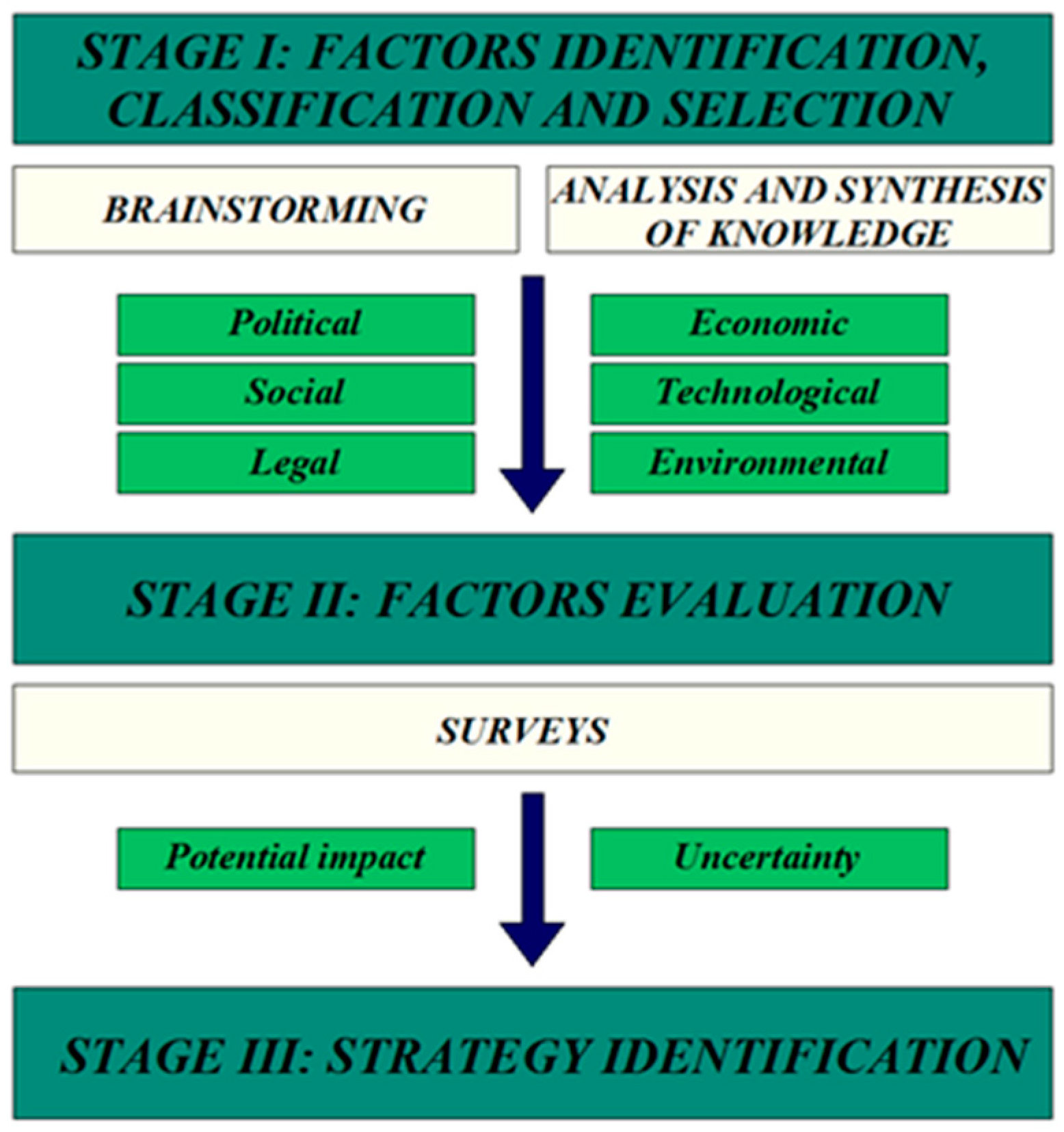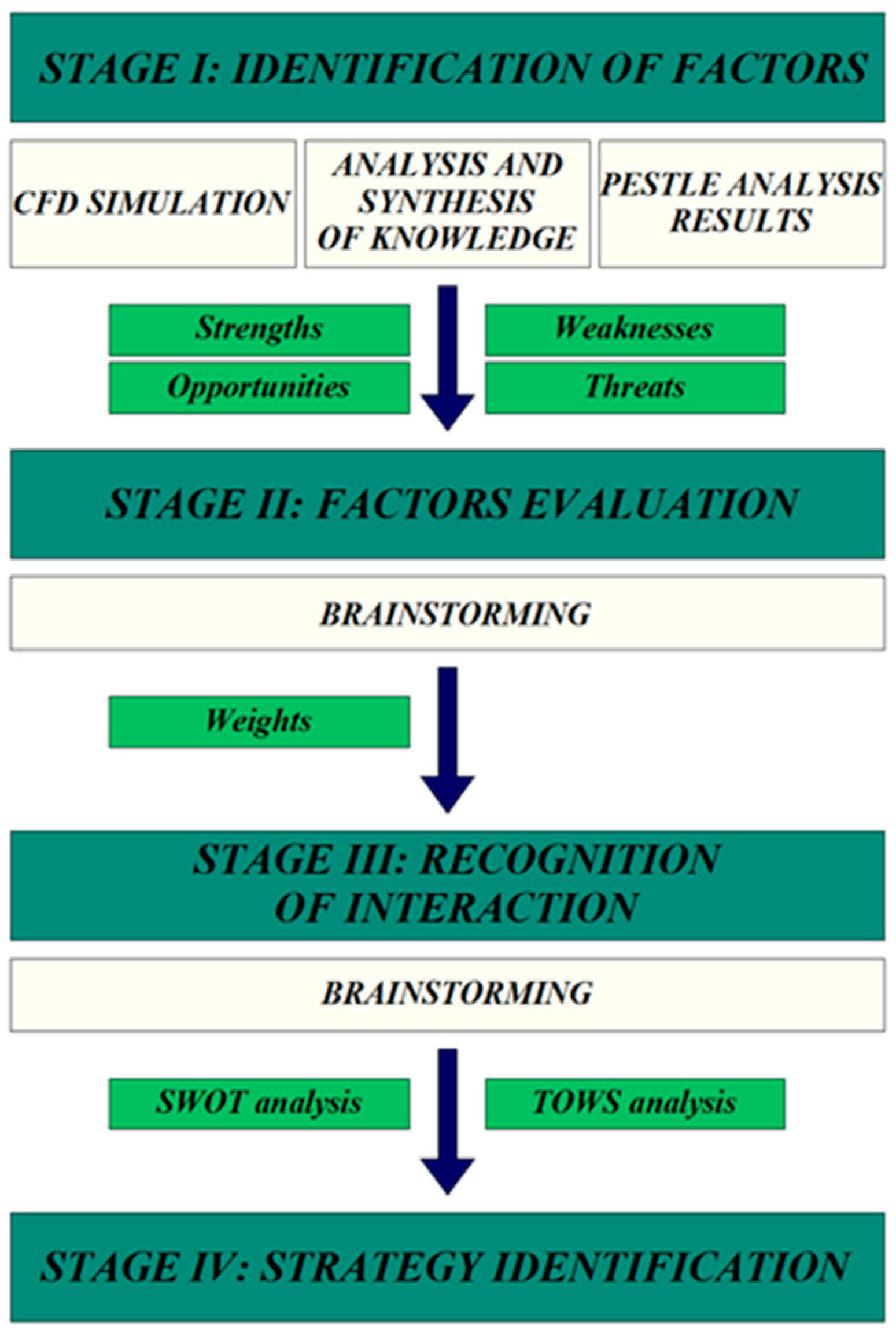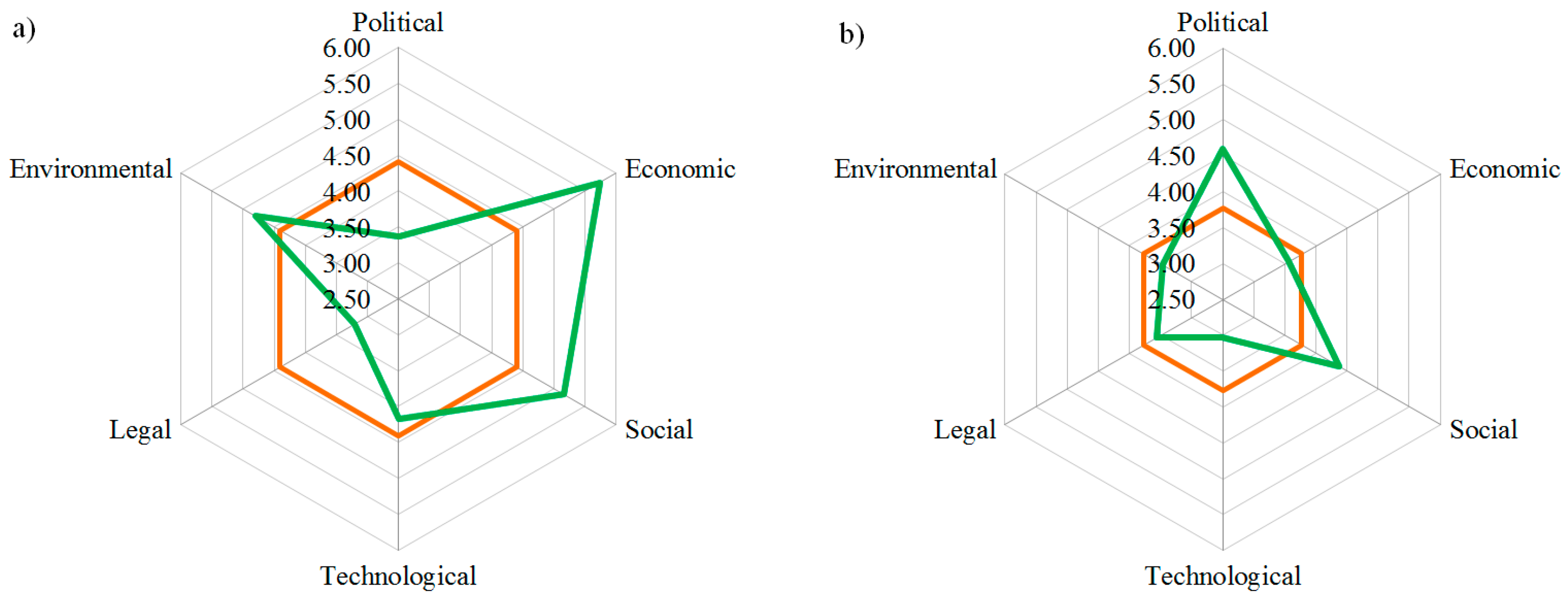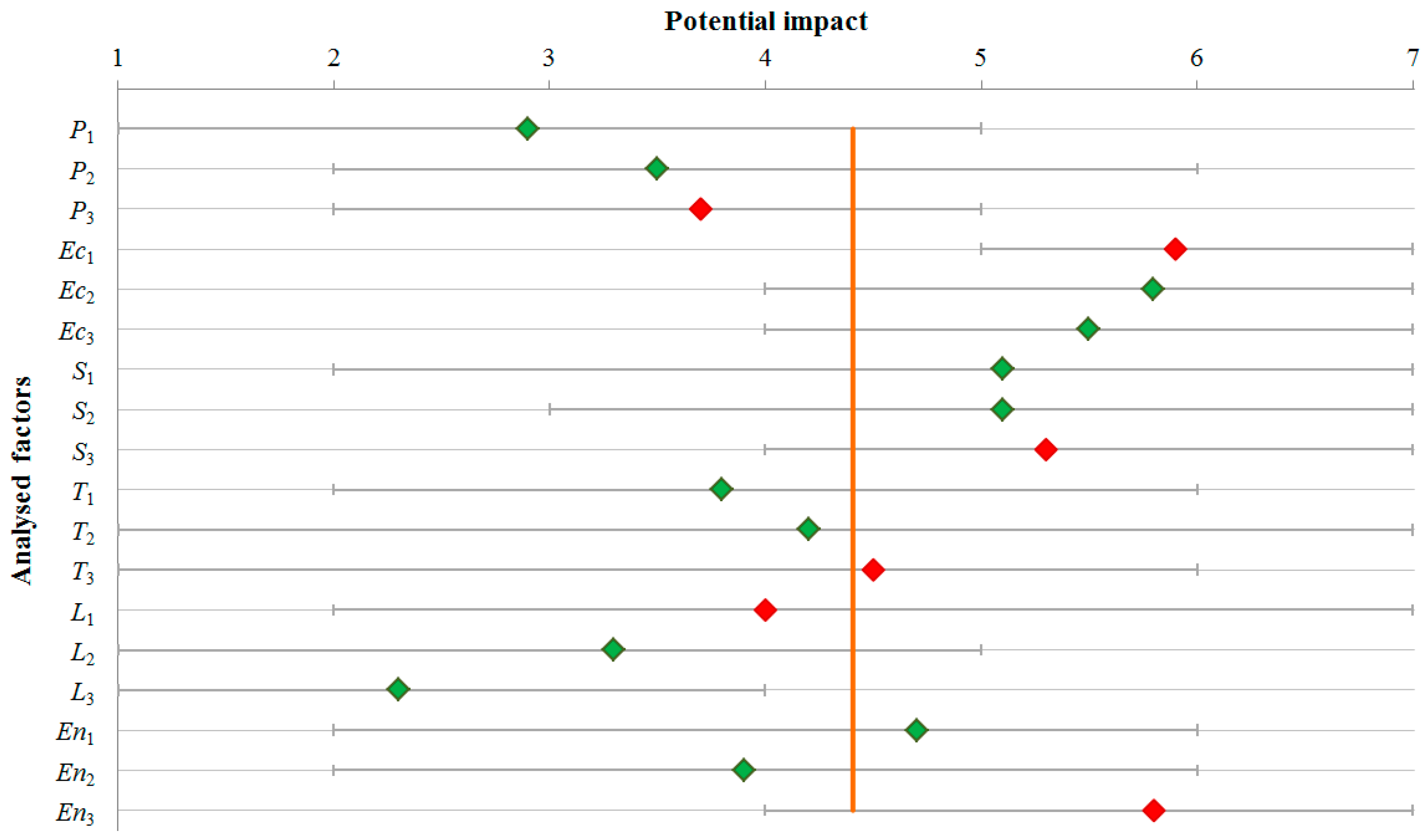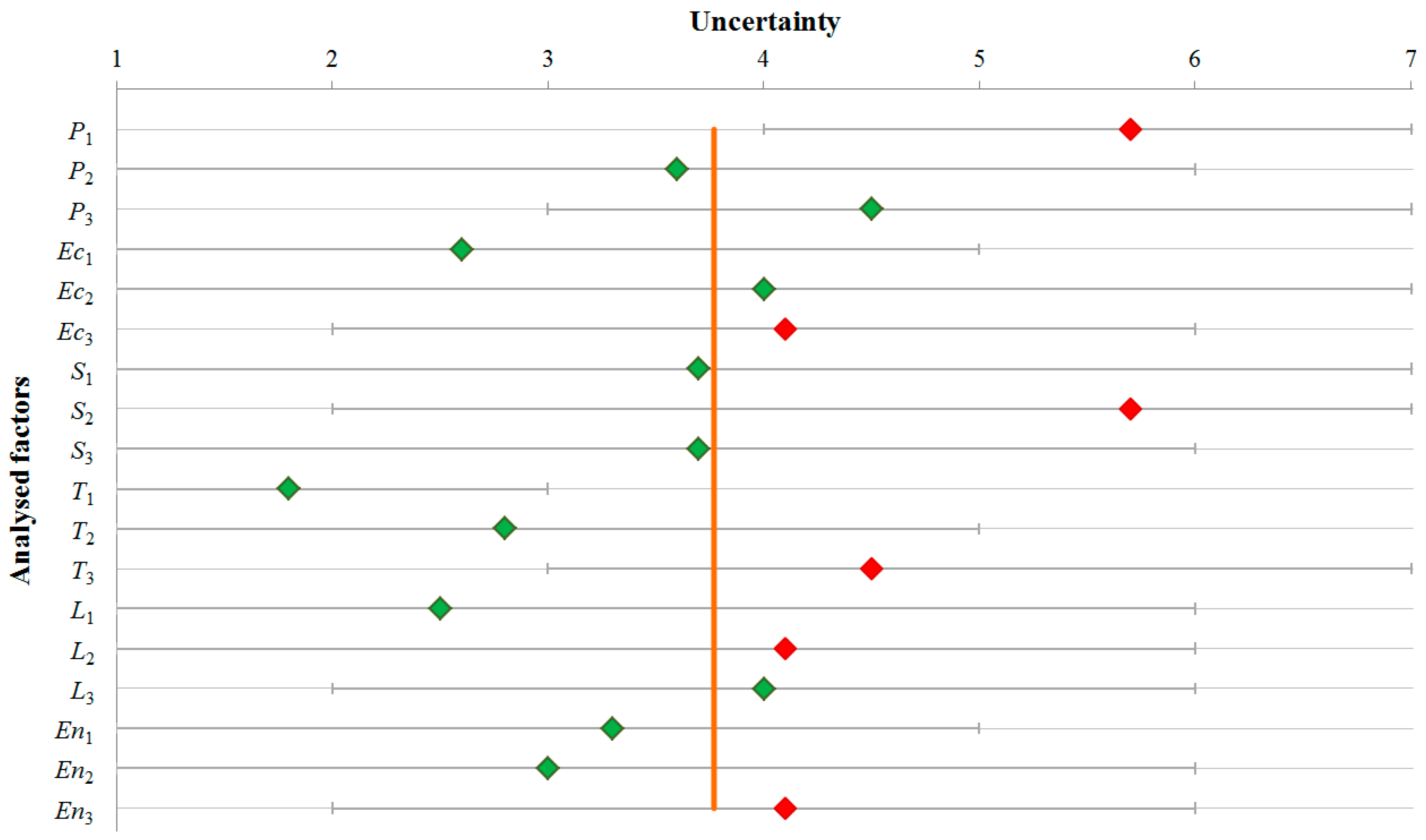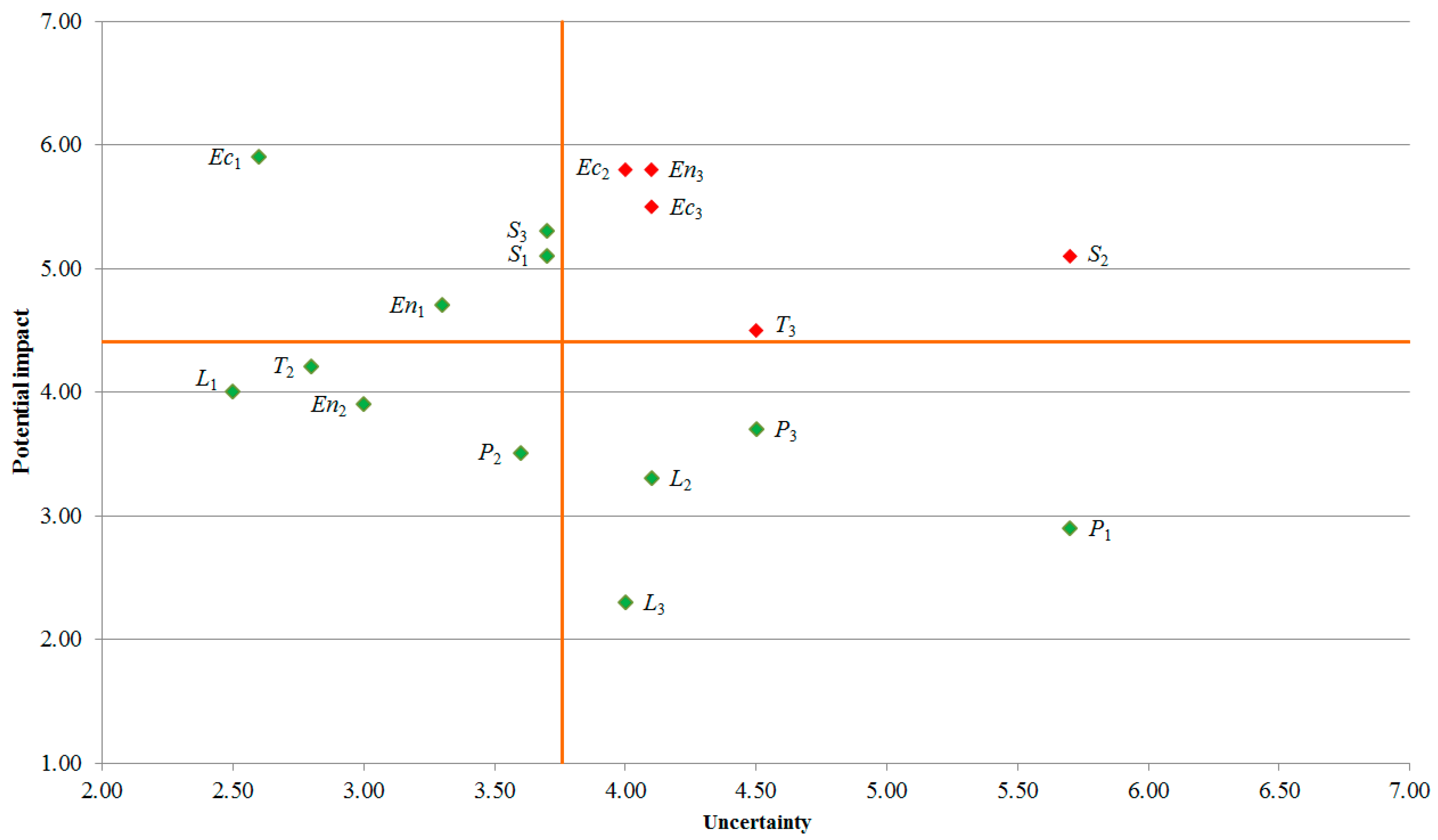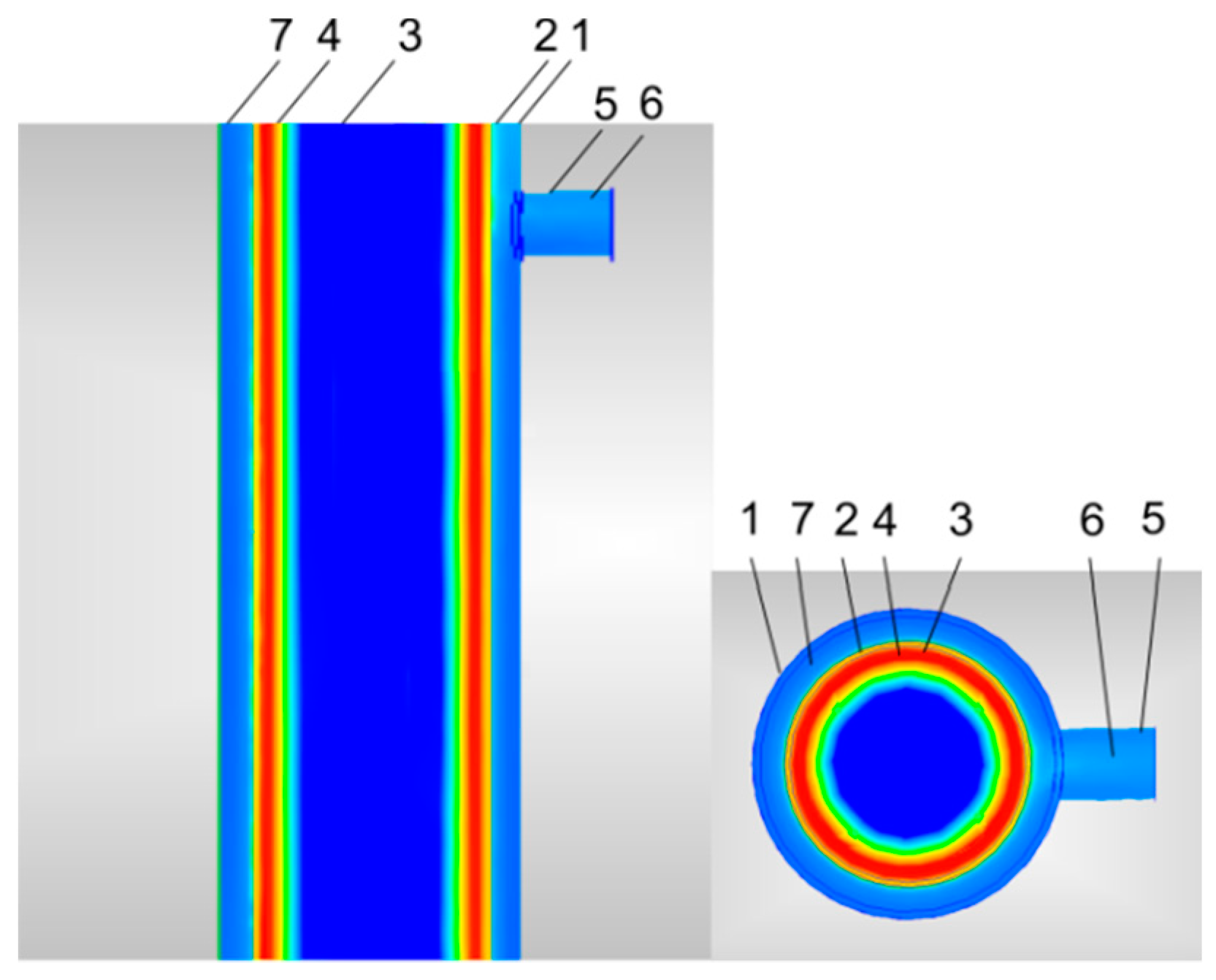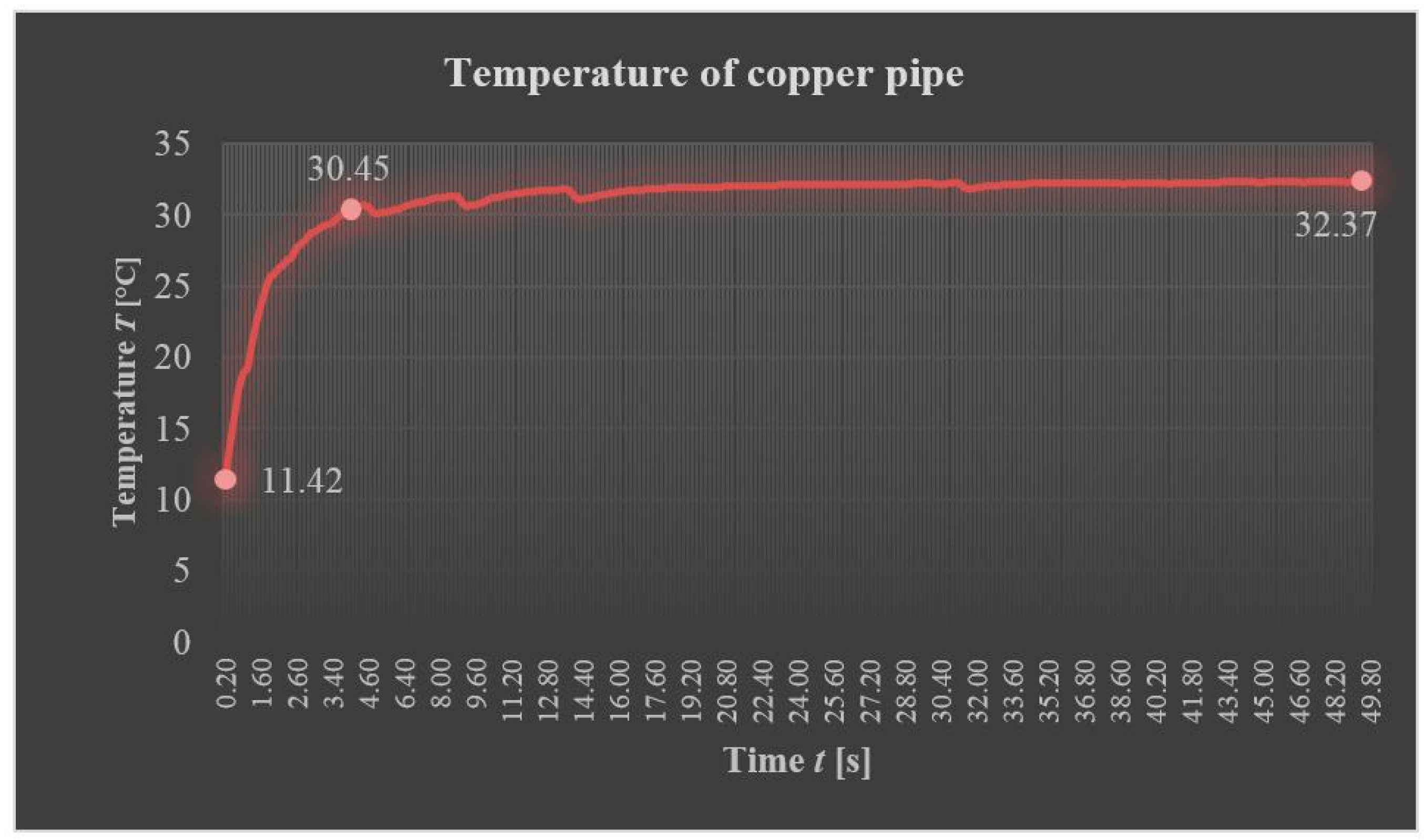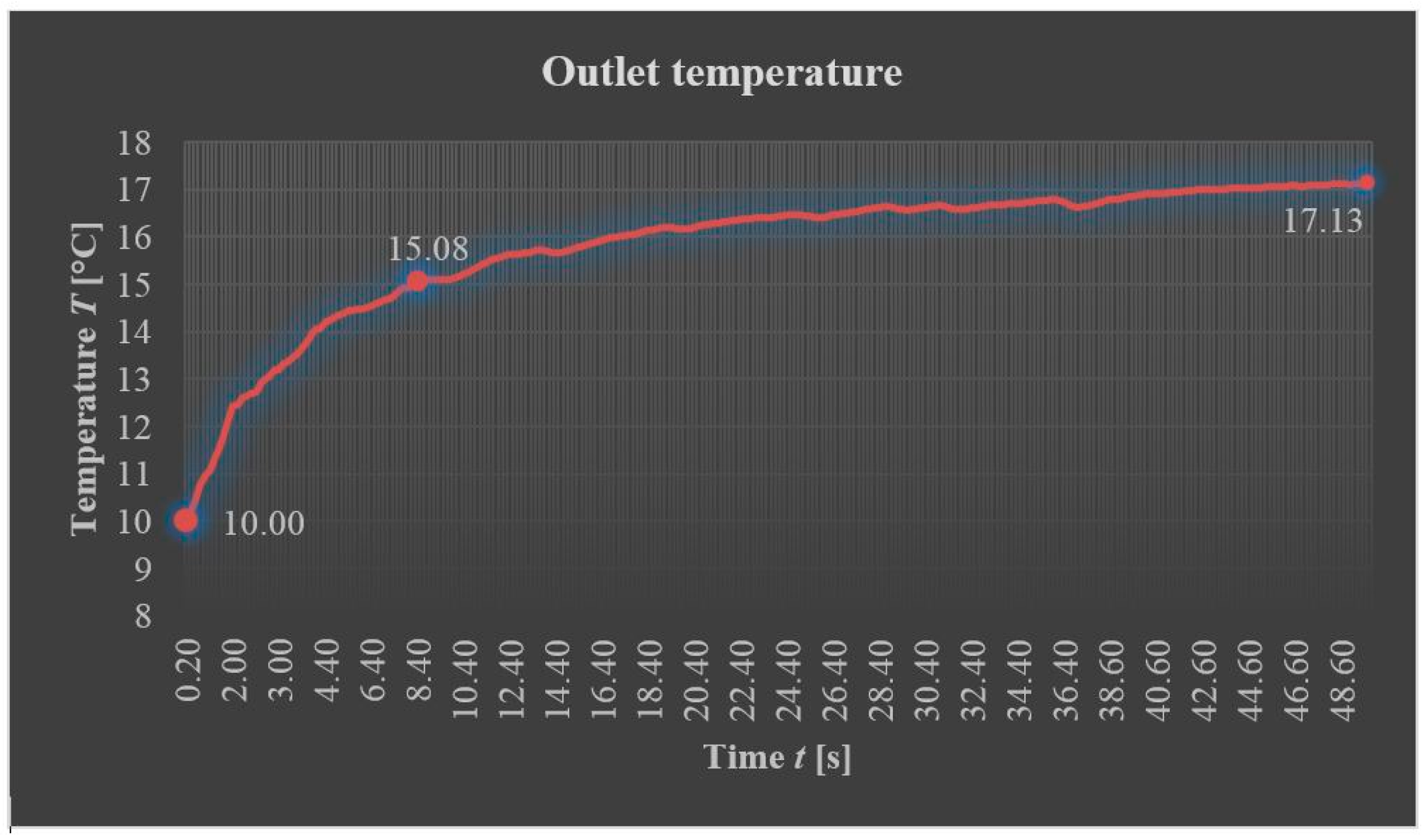3.1. Potential Impact and Uncertainty of DWHR Systems
In order to increase the environmental awareness of the public regarding the possibility of the use of heat recovery systems from drain water discharged from the shower, the average potential impact and uncertainty values of factors assigned to individual groups were determined (
Figure 4). The orange line indicates the global average for all elements, while the green line indicates the average values within individual factor groups. As shown in the study, economic factors were found to play a key role in the development of DWHR systems as assessed by the expert team. The potential impact of these factors was estimated at 5.7 (
Figure 4a). Social factors (5.2) and environmental factors (4.8) were also above the average value (4.4). The lowest importance was ascribed to legal factors (3.2). The differences were also observed in relation to the uncertainty of the elements (
Figure 4b). The highest notes were ascribed to political (4.6) and social factors (4.4). Technological factors were judged most certain as evidenced by the uncertainty score of 3.0, with global average of 3.8.
Figure 5 and
Figure 6 show the results of surveys regarding the potential impact of individual factors on the development of DWHR systems and their uncertainty within a time framework of the nearest 20 years. Grey horizontal lines illustrate the ranges of responses obtained for the factors, while green and red dots indicate arithmetic means. Red dots are used for factors with the highest scores within particular categories. Vertical orange lines show the global averages for all elements included in the study.
The highest potential impacts were ascribed to: Ec1 (capital expenditure levels), Ec2 (public financing level and availability of other funds for building DWHR systems), En3 (ability to reduce fossil fuel consumption and greenhouse gas emissions). The average scores of these factors were above 5.8, and none of the experts considered them to be insignificant. The lowest scores (below 3.0) were ascribed to factors L3 (preferences concerning the use of sustainable technologies in public procurement) and P1 (strategy for implementing sustainable development principles). The latter, however, was characterized by the highest uncertainty score (5.7). The same score was also ascribed to the social factor S2 (level of social acceptance of DWHR systems). The highest certainty was, in turn, ascribed to the technological factor T1 (supply of systems dedicated for heat recovery from drain water), reflecting the broad scope of available solutions for DWHR systems. This diversity allowed us to choose the optimal solution taking into account the size of the installation, the efficiency of devices and their prices, as well as the availability of space for development of the system.
The results of the impact and uncertainty surveys were placed within the Impact/Uncertainty Grid shown in
Figure 7. The factors that are marked in red, including Ec
2 (public financing level and availability of other funds for building DWHR systems), Ec
3 (level of financial benefits stemming from the use of DWHR systems), En
3 (ability to reduce fossil fuel consumption and greenhouse gas emissions), T
3 (experience in operating DWHR systems), and S
2 (level of social acceptance of DWHR systems), are critical uncertainties. The remaining elements located above the horizontal line corresponding to the average global impact of factors may be considered predetermined elements as defined in [
37]. Factors located below the horizontal line are secondary elements [
37].
The analysis showed that factors that are often marginalized or completely neglected are of key importance for the development of Drain Water Heat Recovery systems. Although the importance of economic factors has been known for a long time, the importance of such factors as level of social acceptance of DWHR systems or experience in operating them is usually disregarded. These factors are considered at a later stage of the study.
3.2. SWOT/TOWS Analysis Results of DWHR Systems
In order to increase the environmental awareness of the public regarding the possibility of the use of heat recovery systems from grey water discharged from the shower, the SWOT analysis of such a solution was conducted.
Table 3 lists the three most important factors describing the strengths and weaknesses of the systems under consideration, as well as the potential opportunities and threats associated with their implementation. On the basis of the opinion of the same expert team, there were assigned the following weights. They are included in the further part of the analysis, the results of which are described in this paper.
The strengths of heat recovery systems from grey water included the ability to clearly reduce consumption of fossil fuels in comparison to the situation when installations are operated conventionally. The application of DWHR units allows recovering about 30% to over 60% of the energy carried by wastewater [
53]. The highest benefits are noticeable in the case of vertical heat exchangers, which have the largest surface area of heat exchange between the discharges of wastewater from the shower and heated water. This is due to the fact that the wastewater introduced into the vertical pipe does not fill the entire cross-section, but flows down the walls. This has been verified by performing simulations of fluid flow in the DWHR unit using the software for modeling fluid dynamics Autodesk Simulation CFD 2016. The results of the simulation are shown in
Figure 8 where the space occupied by the flowing sewage has been marked in red.
CFD analysis indicates a significant energy potential of grey water flowing through the heat exchanger. As part of the study conducted, the temperature on the outer plane of the copper pipe at a height of connecting the outlet of the heated water was determined. The temperatures obtained in the initial phase of the device operation are presented in
Figure 9.
During analysis of the DWHR heat exchanger operation, it was observed that the temperature increase on the wall of the copper pipe at the point of contact with water took place in the first seconds of operation of the device. After ~4 seconds, this temperature exceeded 30 °C, and in a further simulation time it was followed by its stabilization.
Another strong point of the project is the fact that in contrast to renewable energy sources the availability of grey water is completely decoupled from the prevailing weather conditions. Preferences regarding the temperature of mixed water do not change throughout the whole year. As a result, fluctuations in temperature of grey water discharged to the sewer system are insignificant, which ensures stable operation of the system.
The final strength of the systems in question, which was included in the analysis, is a possibility to integrate heat recovery system from drain water with installation that uses renewable energy sources. For example, in [
54] cooperation between a DWHR heat exchanger with solar collectors has been described. It is also noteworthy that the recovery of thermal energy contained in the grey water may be carried out together with its recycling [
55].
The weaknesses of the DWHR systems include the dependence of the system efficiency, and consequently the costs of savings achieved, on the operating parameters of the installation such as the flow rate of mixed water from the tap and the usage time of water of the defined temperature. Meanwhile, wastewater outflow from the buildings (especially detached houses) is unpredictable and uneven [
56]. Furthermore, the configuration of a heat recovery system is of great importance as it determines the share of the water flowing through the heat exchanger in its total energy consumption [
57]. Accordingly, the clear identification of cost-effectiveness of such a system is not possible, which results in the need for the respective detailed analysis of technical and financial potential solutions.
A critical parameter for the heat exchange process in the heat exchanger is the velocity of water in the water jacket. The consequence of failure to obtain the water velocity ensuring a turbulent flow is the reduction of the possibility of waste energy recovery. This weakness of the project was also analyzed using the CFD modeling software. During observation of the hydraulic parameters of the model of the heat exchanger, it was noted that this velocity was correlated with the thickness of the water jacket. The greater layer thickness of water around the inner vertical, the lower water velocity.
Velocities of water in the heat exchanger discussed are summarized in
Table 4.
For the obtained hydraulic conditions of the flow of water and grey water, a graph was drawn which shows the change in temperature of heated water in the outlet connector. The registered temperature variation over time is presented in
Figure 10.
During the analyzed period of time cold water was heated from 10 °C to 17.13 °C. The temperature rise of 7 °C obtained within 49 s is negligible, which is due to the low velocity of water in the water jacket, equal to about 0.3 m/s. In the present case, it would be advantageous to change the heat exchanger to another one, which is characterized by a smaller cross-sectional area of the water jacket. It would result in an increase in water velocity, and thus also give a greater degree of energy recovery. However, it is worth noticing that obtaining the velocity at the required level often requires the use of a water jacket of thickness of 2 mm or less, and making a device with such a high precision increases production costs significantly.
In addition, the attention should be paid to the fact that the shower length is not identical with the duration of heat recovery from drain water. Although the recovery of heat from grey water takes place in the first seconds of operation of the device, as shown in
Figure 6, it should be noted that the water temperature at the outlet of the heat exchanger reaches the desired level only after 60–90 seconds [
58]. Very often, this phenomenon is not taken into account in the analysis of the profitability of the use of these devices.
Objections from potential users are enhanced by the relatively high investment costs to be incurred for the purchase and installation of a suitable device. Depending on its design and efficiency, the cost of buying a heat exchanger designed for use in detached houses can vary widely from less than €450 to more than €700. In many cases, the price of the device, in addition to the cost of installation, does not include the cost of transport from another country.
In addition to internal factors, the article also examines external ones on the use of heat recovery from grey water discharged from the shower. Opportunities for DWHR systems include the possibility of improving the environment conditions associated with the reduction in demand for conventional fuels. As a result of the reduction of fossil fuels consumption, the emission of combustion products into the atmosphere is reduced as well. The use of Drain Water Heat Recovery systems will not solve the problem of the devastating impact of the energy sector on the environment on a global scale, however, it may be a small building block in building a sustainable energy policy.
The opportunity of a properly designed and constructed drain water heat recovery system is also its safe and convenient operation, as the DWHR units operate unattended and their construction prevents contact of waste water and heated water. In addition, reducing the difference in temperature of water at the inlet and outlet of the instantaneous water heater the heat exchanger operates with can increase the efficiency of water heating.
The reduction of energy used for the preparation of hot water is also accompanied by a clear reduction of costs for energy supplies in a building. The savings achieved are greater the higher the price of energy, which is why the use of the DWHR system will protect the family budget in case of a significant increase. However, this is an insufficient incentive for citizens. It is therefore vital to acquire an additional source of funding that would enable increasing the financial benefits gained.
The factors threatening the implementation of DWHR systems include, in turn, the inability to clearly identify the period of return on investment, because it depends on several factors such as the characteristics of the use of the shower installation or type of fuel used. For example, unexpected change of operated hot water heater from electric to gas will result in a significant reduction of achieved financial benefits in relation to the expected values.
Another threat for the analyzed systems is the lack of acceptance on the part of potential users, which is a natural consequence of insufficient knowledge about the rationality of the use of DWHR units and negligible experience in their using. In addition, the negative external factors include the lack of experience in operating DWHR systems and guidelines for their use.
In further research the occurrence of interaction between the elements assigned to groups of internal and external factors was analyzed. In order to ensure comprehensiveness and credibility of the study, the occurrence of interactions was tested both by SWOT and TOWS analysis. Based on the guidelines described in [
59], eight subsidiary tables were developed, which determined the total number of interactions and the products of the interactions and the weights assigned to each factor. The combination of quadrants for which the highest sum of products was obtained determines the development strategy of DWHR systems. Products of weights and interaction, which were set for individual elements of the quadrants, also allowed the identification of factors with the highest importance. The results of analysis are summarized in
Table 5,
Table 6 and
Table 7.
The results of the SWOT analysis (“from the inside to the outside”) showed a significant advantage of the interaction occurring between the internal and external positive factors. This suggests that the DWHR systems have significant growth potential, and it is important to aim to maximize the use of favorable opportunities with the shares held by these systems strengths. However, the number of interactions occurring between the internal and external negative factors are the same. Furthermore, the results of the TOWS analysis (“from the outside to the inside”) suggest that potential threats for grey water heat recovery systems heighten substantially the weaknesses of these systems. Therefore, one should try to reduce the impact of weaknesses and threats, the impact of which can prevent the expansion of the DWHR systems. In case of a comprehensive SWOT/TOWS analysis, the highest sum of products was also achieved for the combination of weaknesses and threats.
Products of weights and interactions designated in the following combinations, which were set for individual elements of the quadrant, also helped identify the factors that have the greatest impact on the analyzed systems. In the case of negative external factors the highest scores in each of the four lists were obtained for the threat associated with the lack of acceptance on the part of potential users. This confirms the need to promote sustainable management of the energy deposited in drain water, since the elimination of the negative attitude of the residents is the key to increasing utilization of DWHR systems. Systematic education and the promotion of sustainable technologies among the residents may lead to greater acceptance for unconventional solutions. Especially important in this regard is the ability to use computer tools that, based on an appropriate algorithm calculation, help to reflect the migration processes of heat. In addition, they allow the implementation of parameters the specific device would operate within, which can significantly increase confidence among potential recipients who themselves can assess the work of the device. The results described can be achieved, among others, using CFD modeling software.
